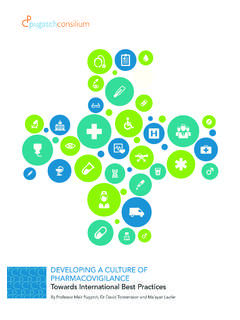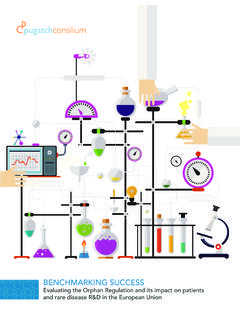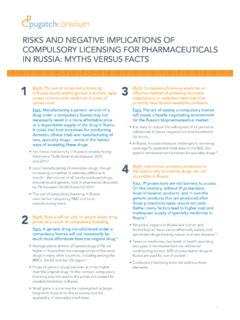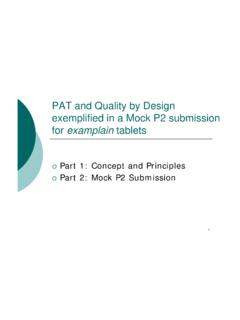Transcription of The evoluTion of Pharmacovigilance - Pugatch …
1 The evoluTion of Pharmacovigilance labeling, Packaging and Pharmacopeia StandardsBy Professor Meir Pugatch , Dr. David Torstensson and Ma ayan LauferSECTIONThe evoluTion of Pharmacovigilance2 This report was commissioned by Novartis Pharmaceuticals Corporation. The views represented here are those of the authors Pugatch Consilium 2015 The moral right of the authors has been rights reserved. Without limiting the rights under copyright reserved above, no part of this publication may be reproduced, stored or introduced into a retrieval system, or transmitted, in any form or by any means (electronic, mechanical, photocopying, recording or otherwise)
2 , without the prior written permission of both the copyright owner and the evoluTion of Pharmacovigilance3li ST of abbreviaTionS 4execuTive Summary 7inTroducTion 91 caPTuring The ScoPe of Pharmacovigilance 12 Background Pharmacovigilance best practices throughout a medicine s life-cycle The post-exclusivity phase and Pharmacovigilance 142 bioequivalence in reTroSPecT 16 a caSe STudy of The haTch-Waxman acT Background The ANDA pathway and the bioequivalence requirement Methodological challenges to the bioequivalence model Summary 213 mainTaining a culTure of Pharmacovigilance 23 in The areaS of Packaging, labeling and PharmacoPeia Packaging and labeling 23 The EU s Regulation 198/2013 A case study Pharmacopeia standards 314 concluSionS and recommendaTionS 36 TableS and figureS Table 1 Key provisions of the Hatch-Waxman Act 16 Figure 1 Comparing FDA approval process requirements for NDAs and ANDAs 18 Figure 2 Growth of the additional monitoring list, distributed by reason for inclusion 28 Table 2 Distribution of selected medicines under additional monitoring 29 by therapeutic class, 2015 Table 3 Distribution of medicines under additional monitoring by reason 29 for inclusion.
3 2015 Table 4 Distribution of medicines under the PASS requirement by type 30 and status, 2015conTenTSThe evoluTion of Pharmacovigilance4adr Adverse Drug Reactionae Adverse Eventanda Abbreviated New Drug Application aPi Active Biopharmaceutical IngredientcgmP Current Good Manufacturing Practice chmP Committee for Medicinal Products for Human UseciomS Council for International Organizations of Medical Sciencescmc Chemistry, Manufacturing and Controls ema European Medicines Agencyfda US Food and Drug AdministrationgcP Good Clinical PracticesgdP Good Distribution PracticesgmP Good Manufacturing Practicesich international Conference on Harmonization of Technical Requirements for Registration of Biopharmaceuticals for Human Use nbcd Non-Biological Complex Drug nda New Drug ApplicationnTi Narrow Therapeutic Indexoecd Organisation for Economic Co-operation and DevelopmentPi Prescribing InformationPmda Japan s Pharmaceutical and Medical Devices AgencyPrac Pharmacovigilance Risk Assessment CommitteePvP Pharmacovigilance Planqbd Quality by DesignliST of abbreviaTionS The
4 evoluTion of Pharmacovigilance5r&d Research and Developmentrld Reference Listed DrugrmP Risk Management PlanSPc Summary of Product CharacteristicsTga Australia s Therapeutic Goods AdministrationWho World Health Organizationadditional definitionsbiopharmaceutical A term used to describe and include both chemical based medicines (which are manufactured using a chemical process and products) as well as biologics which are medicines that are inherently biological products developed with biological sources and process. Throughout the paper, the terms biopharmaceutical, drug, medicine and medicinal product are used of abbreviaTionS The evoluTion of Pharmacovigilance6 The evoluTion of Pharmacovigilance7 The safe use of medicines is perhaps the single most important criteria that any regulatory authority within a given country has to ensure, in order both to protect public health and the integrity of its healthcare system.
5 Pharmacovigilance is the name given to the mechanisms and tests that together map and ensure the safety of a medicine throughout its life span from test tube to many developing and emerging markets are still grappling with the challenges of putting in place the fundamental institutions and processes of a Pharmacovigilance framework, most high income developed markets have already robust systems of Pharmacovigilance in place. Still, even in developed markets challenges remain. In fact, over the last few years a number of new Pharmacovigilance challenges have emerged, particularly in a given medicine s post-exclusivity phase. When an innovative medicine enters the market it has several years of exclusivity, originating from its patent and/or market exclusivity protection.
6 Once this exclusivity period expires, new follow-on generic participants can enter the market. The expiry of this exclusivity period and subsequent time period raises several specific Pharmacovigilance questions relating to manufacturing, packaging, labeling and the use of pharmacopeia standards for regulatory purposes as well as more broadly the question of how all types of products (innovative, generics, small molecules as well as big ones) should be monitored. The purpose of this report is to examine some of these challenges in the areas of packaging and labeling, and pharmacopeia standards. This is an important topic as differences and gaps in the regulatory framework for these areas have the potential to have a significant impact on standards of quality, patient safety and incentives for biopharmaceutical innovation and R&D.
7 The report provides a thematic discussion of these areas, the new Pharmacovigilance challenges they pose and the different policies and actions taken by major DRAs in addressing (or not fully addressing) these challenges. Overall the report finds that a more holistic approach is necessary in which standards of Pharmacovigilance are applied to all types of medicines be it innovative or generic, small-molecule or complex, chemical or biologic. Looking at the additional monitoring initiative taken by the EMA in 2013 as a case study example, the report finds that EMA s policy ambiguity regarding the inclusion of products with multiple manufacturers has resulted in what appears to be an inconsistency and gap between the treatment and monitoring of reference products and follow-on generic manufacturers; a significant gap which potentially raises patient safety and public health concerns.
8 Equally with regards to labelling this report finds that the latest academic research shows how there are still serious challenges and gaps in major OECD markets. In particular, there are discrepancies in ADR reports between reference and follow-on on these findings the report makes the following three recommendations:1. ema s medicines under additional monitoring policy should be exhaustive and account for all manufacturers The EU Regulation 198/2013 is a laudable Pharmacovigilance initiative, yet it should be clarified that its requirements apply to all manufacturers and types of products be it innovative or generic, small-molecule or complex, chemical or Pharmacopeial organizations should expedite the inclusion of new monographs A greater emphasis should be placed on maintaining an efficient.
9 Updated and expedited pharmacopeial workflow as it is an essential part of the Pharmacovigilance greater flexibility in labelling In light of the situation in the US after the Supreme Court ruling (Pliva v. Mensing), which left patients with no legal remedy in cases of injuries resulting from inadequate labeling of generic products, governments and DRAs should act to adapt the legal and regulatory frameworks accordingly and enable all manufacturers to promptly change their products labels in accordance with the emergence of new safety SummaryThe evoluTion of Pharmacovigilance8 The evoluTion of Pharmacovigilance9 Biopharmaceutical products are today manufactured, sold, distributed and dispensed across the globe.
10 As patients and healthcare professionals around the world increase their access to and use of more biopharmaceutical products and technologies, the importance of maintaining and, in many cases, introducing and applying comprehensive Pharmacovigilance regulations only increases. Pharmacovigilance is the name given to the mechanisms and controls that together map and ensure the safety of a medicine throughout its life span from test tube to patient. Conceptually, Pharmacovigilance is most commonly thought of in terms of post-marketing surveillance through ADRs reporting and through so-called phase IV clinical But as is discussed below the practice of Pharmacovigilance is actually an integral part of a biopharmaceutical product s entire life cycle, from clinical development to the introduction of follow-on generic products.



